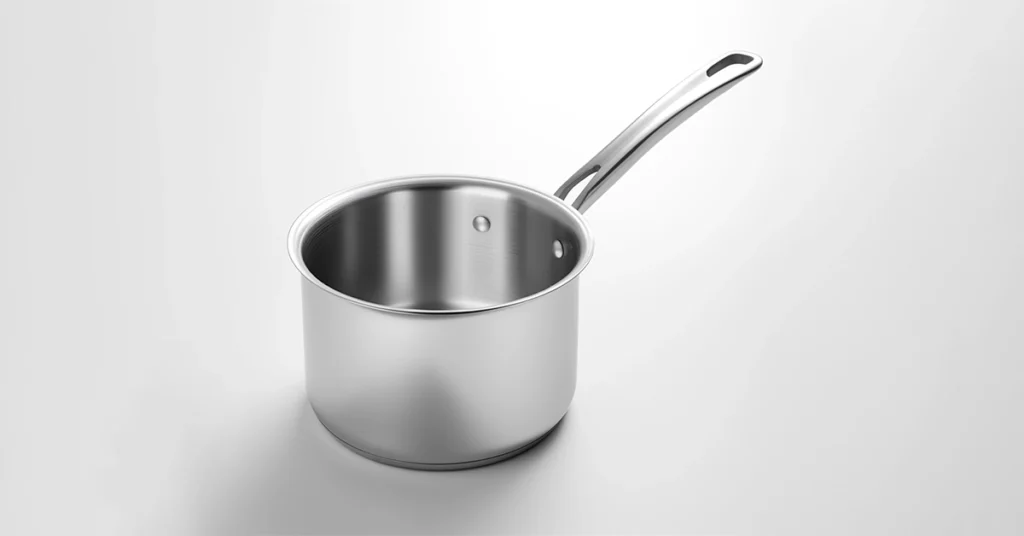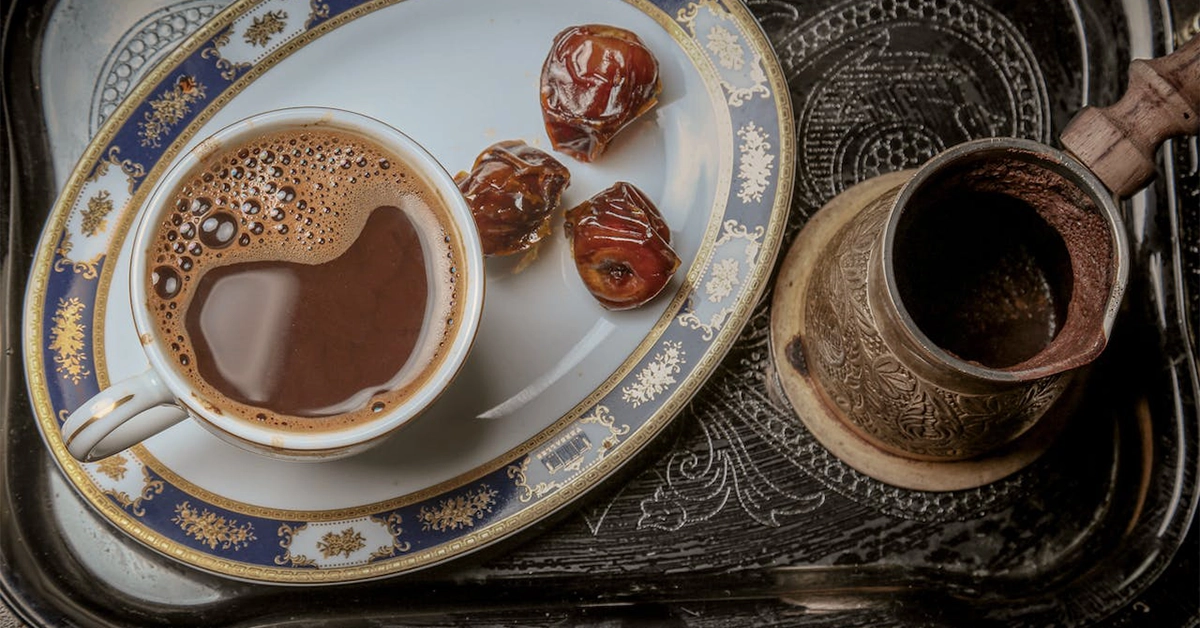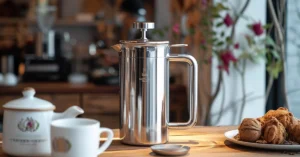Turkish Coffee: This traditional brew, steeped in history, is known for its strong, unfiltered character and fine grind. But what if you don’t have a cezve, the traditional Turkish coffee pot? No worries! You’re about to discover how to make Turkish coffee without a cezve (also known as an Ibrik), which is a special pot designed for brewing this type of coffee. However, not everyone has access to one.
Whether you’re a coffee enthusiast or a curious beginner, our guide will walk you through alternative methods, ensuring you can enjoy this cultural gem right from your kitchen. So, grab your favorite coffee cup, and let’s dive into the art of brewing Turkish coffee without the classic cezve.
What Turkish Coffee Is All About
The tale of Turkish coffee begins in the 15th century, anchored deeply within Middle Eastern culture. Over the centuries, this aromatic beverage has become a significant part of my heritage, serving as a symbol of hospitality and social interaction.
What sets Turkish coffee apart for me is its intense flavor and thick consistency. It’s made using very finely ground coffee beans, as fine as powdered sugar, which contributes to its full-bodied taste and velvety foam—a signature feature that I particularly cherish.
Typically, when I serve it, Turkish coffee cups, which are usually small and elaborate, enhance the experience as they underscore the coffee’s strong connection to tradition.
Using a cezve—a special pot usually made of copper or brass with a long handle—is integral to traditional Turkish coffee preparation. The cezve’s unique design allows for fine control of temperature and even heat distribution, crucial for crafting the perfect cup.
How To Make Turkish Coffee Without A Cezve: Alternatives
When exploring how to make Turkish coffee without a cezve, you can turn to the handy tools you already have in your kitchen. These alternatives open up new ways to enjoy this richly flavored brew. From a small saucepan to an espresso maker, each option brings its unique touch to the traditional Turkish coffee experience.
Small Saucepan
My go-to alternative for a cezve is a small saucepan. This is something practically everyone has in their kitchen. Just add the water and coffee grounds directly into the pan. I ensure that I stir the mixture frequently to prevent the grounds from settling at the bottom.

Fire-Resistant Cup or Mug
A fire-resistant cup or mug is a great option for making Turkish coffee at home or while camping. This method is as simple as it gets: combine water and Turkish coffee grounds in the mug, and place it directly on your kitchen stove or campfire.

Preparing the Coffee Grounds

Before we embark on the journey of how to make Turkish coffee without a cezve, let’s focus on prepping our coffee grounds. The key to capturing the essence of authentic Turkish coffee lies in the grind and freshness of the beans. A fine grind is essential, as it allows for a full extraction of flavor, crucial for replicating the rich taste we associate with traditional Turkish coffee.
Achieving the Right Grind
When I’m grinding coffee for Turkish brew, the goal is to have finely ground coffee beans. Turkish coffee requires a powder-like consistency, finer than what is used for espresso. You might hear that it should be as fine as caster sugar.
I use a commercial-grade grinder to achieve this, as a standard blade grinder often can’t get it fine enough. Occasionally, I include a pinch of ground cardamom for an authentic flavor twist—it’s entirely optional but delightful.
Importance of Freshness
The importance of using fresh coffee beans, specifically Arabica beans due to their superior flavor profile, can’t be overstated. I always seek high-quality coffee beans, preferably purchased in small quantities to ensure they’re fresh.
After grinding my beans, I store any leftovers in an airtight container to preserve their freshness. Remember, even the best finely ground coffee beans will lose their oomph if they’re not kept fresh. So, if I’m not grinding my beans just before brewing, I make sure they’re stowed away properly to maintain that rich, delicious flavor.
Key Considerations for Brewing

In mastering how to make Turkish coffee without a cezve, I pay close attention to several crucial factors.
- The quality and temperature of the water,
- the precise ratio of coffee to water,
- and the timing of the brewing process are all pivotal.
Especially critical is monitoring for the foam’s formation, a hallmark of properly brewed Turkish coffee. These elements collectively ensure that even without a traditional cezve, the coffee retains its authentic richness and unique character.
Water Quality and Temperature
The quality of the water I use is pivotal to the taste of the coffee. I always go for cold water that’s free of impurities to begin with, as this affects not only the taste but also how the coffee behaves during heating. The water temperature is another crucial factor; I heat it gently to just before boiling. This is to avoid scalding the finely ground coffee, which can cause a bitter taste and ruin the rich flavor Turkish coffee is known for.
Coffee to Water Ratio
When crafting Turkish coffee without a cezve, the secret lies in the coffee-to-water ratio. I typically use one heaped tablespoon of finely ground coffee for every 3 ounces of water. This ratio is essential for capturing the true essence of Turkish coffee. If a sweeter taste is desired, adding sugar at the start is ideal, as it melds seamlessly with the earthy, robust flavors, creating a perfectly balanced cup.
Timing and Watching for the Foam
Timing is essential. I watch the pot closely on the stovetop for when the foam starts to form. This foamy layer is a signature aspect of Turkish coffee, so I aim to remove the pot from the heat just as the foam rises—right before it boils over. This technique allows me to capture the essence of strong coffee with the perfect texture without letting it become too hot and lose its distinct foam-forming quality.
Serving and Enjoying Turkish Coffee

Serving is key when making Turkish Coffee. The art of how to make Turkish coffee without a cezve extends beyond just brewing; it encompasses the finesse of serving and savoring the coffee as well.
From selecting the right cups to accompanying the coffee with traditional sweets, every detail contributes to the authentic enjoyment of this rich and aromatic beverage
Traditional Serving Practices
When I serve Turkish coffee, I use Turkish coffee cups, which are small and elegant, often adorned with intricate designs. These cups are similar in size to espresso cups and help preserve the coffee’s temperature and flavor. In my ritual of serving, I pour coffee into each cup slowly, allowing the fine grounds to settle, and I ensure that the rich foam created during brewing is distributed evenly among the cups.
Pairing with Turkish Delights or Other Sweets
After mastering how to make Turkish Coffee without a Cezve, the next step is to pair it perfectly with sweets. A piece of Turkish delight or a slice of baklava is not just a treat; it’s a tradition that complements the intense flavors of the coffee. The sweetness of these desserts beautifully balances the robustness of the brew. For an extra touch, I like to sprinkle a bit of cinnamon or cardamom on top of the sweets, enhancing their flavors and elevating the entire coffee experience.
Reading Coffee Grounds – A Fun Tradition
After enjoying the coffee, a unique tradition I love is reading the coffee grounds. This is done by flipping the coffee cup upside down onto the saucer and letting it cool. I, as well as many others I know, find enjoyment in playfully interpreting the patterns for insightful predictions about the future. It’s a fun and engaging activity for anyone who relishes in the art of coffee.
Troubleshooting Common Issues
When I make Turkish coffee without a cezve, a few issues can affect the quality of my brew. I’m going to walk you through fixing common problems like lack of foam, over-boiling, and gritty texture, which are crucial to nailing that perfect cup.
Lack of Foam
Foam is essential for a good Turkish coffee, and I aim for a rich, frothy layer. If my coffee lacks foam, I make sure the coffee grounds are extra fine because coarse grounds don’t produce much foam. Stirring gently while the coffee is cold can help distribute the coffee evenly before I start heating it.
Over-Boiling
The trick is never to let Turkish coffee boil. If I see the bubbles start to rise too rapidly, I immediately remove the pot from the heat. Over-boiling creates a bitter taste and kills the foam. To prevent this, I watch the pot closely and keep the heat on medium, ready to pull the pot away as soon as I see the first signs of a simmer.
Gritty Texture
A good Turkish coffee should be bold but not gritty. To combat a gritty texture, I ensure my coffee is ground to a powder-like fineness. If it’s still gritty, I let the coffee settle for about 30 seconds after pouring it into my cup, which allows the grounds to sink to the bottom, resulting in a smoother texture.
My Personal Opinion on Turkish-Brewed Coffee
I’ve always found Turkish coffee to be an incredibly delicious experience, one that stands apart from other brewing methods. It’s the rich flavor and the earthy tones that draw me in every time I have a cup. With its finely ground beans, Turkish coffee provides a taste sensation that truly honors the essence of high-quality coffee.
When I make Turkish coffee without a cezve, I pay particular attention to the grind of the beans. They must be extra fine, almost like powder, to get the traditional texture right. For me, the ritual of making Turkish coffee is almost meditative. The focus on details, the slow stirring, watching the foam rise—it’s all part of the charm that makes this coffee so special.
What I enjoy most about Turkish coffee is its boldness. Every sip is packed with flavor, yet it never overwhelms my palate. The balance is perfect for those mornings when I want to wake up to something powerful yet comforting.
In my opinion, anyone who appreciates coffee should try making Turkish coffee at least once. It’s more than just a drink; it’s a cultural journey that I’ve found to be both enlightening and incredibly satisfying.
If you are interested in Turkish coffee and other cultures, you also might want to read about the Ottoman coffee table.
FAQ – How to Make Turkish Coffee Without a Cezve
Can you make Turkish coffee without an ibrik?
Yes, you can make Turkish coffee without an ibrik. The ultimate goal is to achieve the right consistency and to keep the coffee grounds settled at the bottom. You can use a small saucepan instead of an ibrik, also known as a cezve.
Can you make Turkish coffee in a French press?
Turkish coffee typically requires a fine grind and a particular brewing method that allows the grounds to settle, which is why using a French press isn’t the standard approach. However, innovative coffee enthusiasts sometimes adjust their methods to use a French press, although it might not yield the same results as a traditional preparation.
How do you make Turkish coffee with a kettle?
To make Turkish coffee with a kettle, you need the coffee grounds to be very fine, finer than what’s used for espresso. Start by boiling water in the kettle, then carefully transfer it to a cup containing the coffee grounds, similar to how you’d make instant coffee. This won’t create the traditional foam on top, but you’ll still get a strong brew.
If you liked our blog post on How to Make Turkish Coffee Without a Cezve, don’t forget to leave us a comment down and share your thoughts on this topic.




